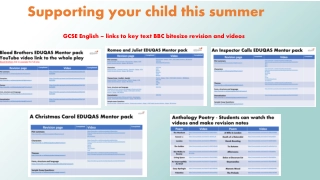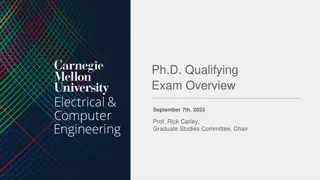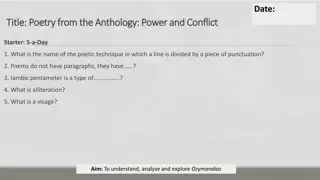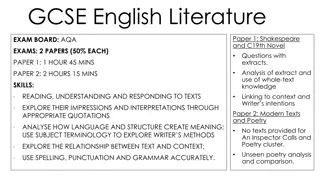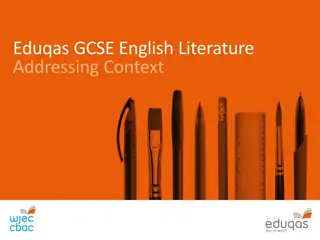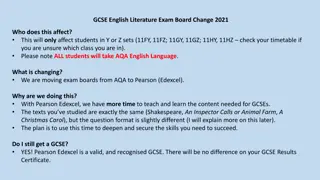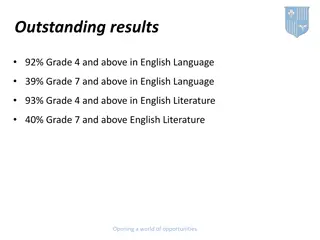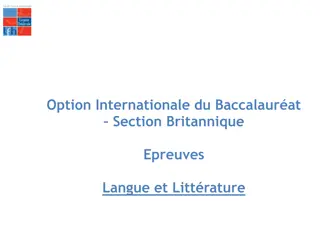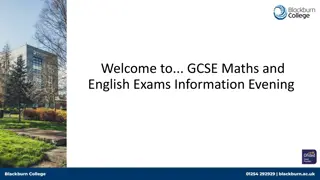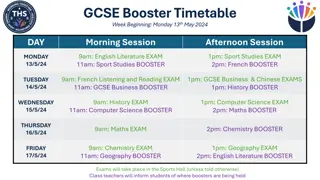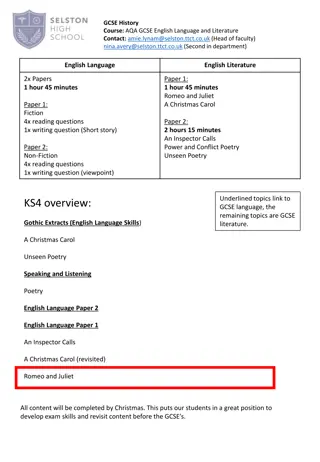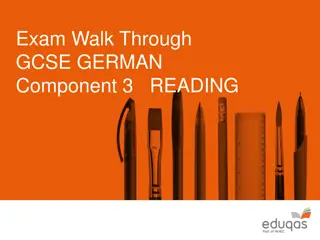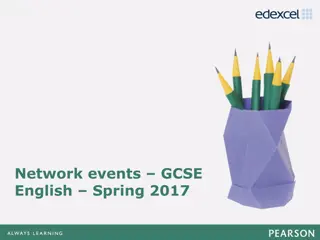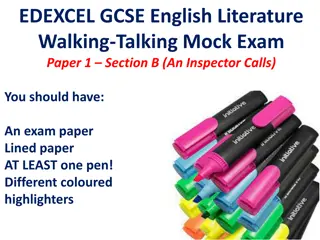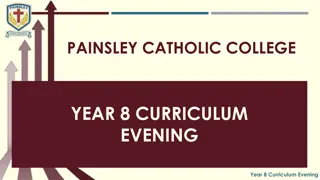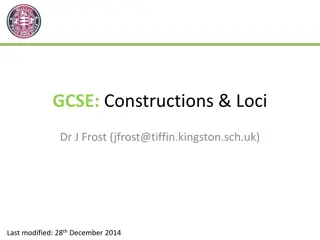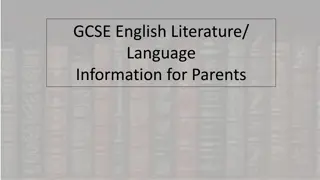GCSE English Literature Exam Overview
This overview provides information on the GCSE English Literature exam structure, content, and assessment objectives for both components. It includes details on the texts studied, such as Shakespeare, poetry, post-1914 prose/drama, and 19th-century prose. Students are assessed on their ability to read, understand, analyze texts, and demonstrate knowledge of the context in which the texts were written. The assessment objectives emphasize critical analysis, language analysis, contextual understanding, and effective communication skills.
Download Presentation

Please find below an Image/Link to download the presentation.
The content on the website is provided AS IS for your information and personal use only. It may not be sold, licensed, or shared on other websites without obtaining consent from the author. Download presentation by click this link. If you encounter any issues during the download, it is possible that the publisher has removed the file from their server.
E N D
Presentation Transcript
Eduqas GCSE English Literature Addressing Context
Specification Content in brief Component 1 Shakespeare and Poetry 40% 2 hours Section A: Shakespeare (20%) One extract question (15 marks) and one essay question (25 marks). 40 marks Section B: Poetry from 1789 to the present day (anthology) (20%) One question on a given poem (15 marks) and one question comparing this poem to another thematically linked poem of own choice (25 marks). Post-1914 Prose/Drama, 19th Century Prose and Unseen Poetry 40 marks Component 2 60% 2 hours 30 Section A: Post-1914 Prose/Drama (20%) One source based question 40 marks Section B: 19th Century Prose (20%) One source based question 40 marks Section C: Unseen poetry (20%) One question on an unseen poem (15 marks) and one question comparing this poem with another unseen poem (25 marks). In common with all exam boards, all examinations are closed book. 40 marks
Texts for Component 1 Section B: Poetry Eduqas GCSE Poetry Anthology The anthology covers a range of poetry from 1789 to the present day and is designed to introduce learners to the rich heritage of poetry across centuries as well as illustrating how poets explore similar themes in different ways. Anthologies are provided free of charge. The poems in the anthology are: The Manhunt Simon Armitage A Wife in London Thomas Hardy Sonnet 43 Elizabeth Barrett Browning Death of a Naturalist Seamus Heaney London William Blake Hawk Roosting Ted Hughes The Soldier Rupert Brooke To Autumn John Keats She Walks in Beauty Lord Byron Afternoons Philip Larkin Living Space Imtiaz Dharker Dulce et Decorum Est Wilfred Owen As Imperceptibly as Grief Emily Dickinson Ozymandias Percy Bysshe Shelley Cozy Apologia Rita Dove Mametz Wood Owen Sheers Valentine Carol Ann Duffy Excerpt from The Prelude William Wordsworth
Text choices for Component 2 Section B: 19th Century Prose Charles Dickens: A Christmas Carol George Eliot: Silas Marner H.G. Wells: The War of the Worlds Jane Austen: Pride and Prejudice Charlotte Bronte: Jane Eyre Robert Louis Stevenson: The Strange Case of Dr Jekyll and Mr Hyde
Assessment Objectives AO1 Read, understand and respond to texts. Students should be able to: maintain a critical style and develop an informed personal response use textual references, including quotations, to support and illustrate interpretations. AO2 Analyse the language, form and structure used by a writer to create meanings and effects, using relevant subject terminology where appropriate. AO3 Show understanding of the relationships between texts and the contexts in which they were written. AO4 Use a range of vocabulary and sentence structures for clarity, purpose and effect, with accurate spelling and punctuation. In the specification as a whole, 20-25% of the marks will require candidates to show the abilities described in AO1, AO2 and AO3 through tasks which require them to make comparisons across texts.
Assessment Objective weightings The assessment objectives and their total weightings are common across all exam boards. However, the percentage allocated to each section may vary across boards. Assessment Objectives can be useful for teachers. However, there is no need for students to memorise them or to remember which AO applies to which question. If students read the questions properly and stick to the focus of the question they will be covering the AOs. AO1% AO2& AO3% AO4% Total % Component 1 15 15 7.5 2.5 40 Component 2 25 25 7.5 2.5 60 Overall weighting 40 40 15 5 100
How the marking works For all questions, each response is marked in five bands with band 5 being the highest. Some of the key words in each band are shown below: Band 5 Sensitive, evaluative, critical, perceptive, original, assured, pertinent Band 4 Sustained, thoughtful, secure Band 3 Focused, straightforward, engaged, relevant Band 2 Some focus, understanding, engagement and support Band 1 Limited focus, understanding, engagement and support
Key approaches Students should know their set texts well and should ensure that they are familiar with key moments from across the whole text. Students should recognise the key features of the three genres (drama, poetry and prose). Students should read questions carefully TWICE before starting a response and should ensure a focus on the task throughout. Terminology or feature spotting should never drive responses- answers should lead with meaning .
Sample questions: Component 1 Section B: Poetry (given poem) Read the poem below, A Wife in London, by Thomas Hardy. A Wife in London is a poem about loss. How does Thomas Hardy present loss in the poem? Remember to refer to the contexts of the poem in your answer. [15] (The poem is printed on the page and a list of all the anthology poems is printed on the facing page)
Approaching the Poetry anthology question (given poem) Read the question TWICE to identify the key focus. Tracking the poem chronologically is the best approach. This should include reference to the title and should go right through to the final line, selecting the most important ideas for the question focus. Make sure that the text is seen as poetry and that there is reference to key elements of poetry texts. While linguistic features such as word classes may sometimes be useful, it is not necessary to label every quote with a word class. Context is assessed here: include a reference to context in the introduction and then integrate contextual references into the rest of the response. Context needs to be specific and accurate.
Sample questions: Component 1 Section B: Poetry (comparison) Choose one other poem from the anthology in which the poet also writes about loss. Compare the way the poet presents loss in your chosen poem with the way Thomas Hardy presents loss in A Wife in London. [25] In your answer you should compare: the content and structure of the poems what they are about and how they are organized how the writers create effects, using appropriate terminology where relevant the contexts of the poems, and how these may have influenced the ideas in them
Approaching the Poetry anthology comparison question Think carefully about your choice of poem before starting to write and make a brief plan so that there are enough points of connection/contrast to make. Ensure the question focus is maintained throughout- comparisons can t be about anything, they must be linked to the question focus. Students should use quotations explicitly for AO2 as well as to illustrate a key aspect of the question focus. As in the first part question, context should be specific, accurate and integrated throughout. Plan for a structured response to enable the best comparative approach e.g. a key point of comparison should be the topic sentence for the start of each paragraph. It is fine to repeat elements of the response to the first part question where this is being used to illustrate a given connection/comparison with the chosen poem.
Eduqas resources to support teaching of the poetry anthology Eduqas Poetry Anthology Resources Using contexts effectively in response to poetry GCSE English Literature Component 1
Sample questions: Component 2 Section B: 19th Century Prose (source based question) The Strange Case of Dr Jekyll and Mr Hyde You are advised to spend about 45 minutes on this question. You should use the extract below and your knowledge of the whole novel to answer this question. Write about Dr Jekyll and how he is presented at different points in the novel. In your response you should: refer to the extract and the novel as a whole show your understanding of characters and events in the novel refer to the contexts of the novel [40] (followed by an extract of about half a page)
Approaching the source based questions The questions for the two sections of Component Two work in the same way. The only difference is that Section B (19th Century Prose) includes AO3 (context) as an Assessment Objective. Read the question carefully TWICE to identify the key focus. The focus of these questions is on the whole text. The extract is to enable a way in and to provide material for AO2. A brief plan should focus on the whole text and include the beginning, key moments and endings of the texts. The extract can be discussed where it best fits (in terms of the chronology of the text). Other approaches include covering the extract first before moving on to the whole text or integrating evidence from the extract throughout the essay on the whole text. All of these approaches are valid. The most important thing is that students spend less time on the source and more time on the whole text.
Approaching the source based questions The texts should be seen as their respective genres and relevant terminology should include terms related to that genre. As the focus of these questions is on whole text study, terminology is more about elements of the bigger picture of how texts create meaning rather than close analysis of individual words (and their word class labels) As before, Students should use quotations explicitly for AO2 as well as to illustrate a key aspect of the question focus. Spelling, punctuation and grammar is assessed in Section A. Proof read, paying attention to spellings of names.
Approaching the source based questions (context) Context IS NOT assessed in the post-1914 text. While it may be relevant to some of the texts in this section, and may help discussion of A01, it should not be a main focus of the response. Context IS assessed in the 19th Century text. It should be mentioned in the introduction and integrated throughout the response where it supports discussion of meanings/ideas/character development or AO2. The development of characters/themes/ideas in relation to the question should drive the response. Context should be used as a supporting reference rather than to drive responses.
Eduqas resources to support teaching of Component 2 Approaches to 19th Century Texts Approaches to Unseen Poetry GCSE English Literature Component 2
Students should Know their texts well and be able to track or map the development of key characters and events. Have a small bank of key quotes for each text, including key quotes for main characters and themes. Be able to recognise the key features of each genre. Stick to the focus of the question and plan briefly so the answer remains focused. Lead with meaning and avoid feature spotting . Remember to include context where asked. Manage their time wisely.
The best students will also Understand that characters and events are constructions of their authors and that there is an authorial intention behind each text. Use key quotes concisely and effectively to cover more than one AO. Be able to use features of each genre effectively to develop ideas and use terminology associated with that genre. Integrate various contexts in a way which supports (but does not overtake) analysis of characters and ideas. Plan a response that has an overview and develops an argument or key train of thought. Write precisely and concisely using apt vocabulary so that they can cover a wide range of the text in each response.
Using Online Exam Review (OER) to help your assessment OER allows you to look at student responses to past exam paper questions. You can view these as unmarked and marked. The statistical table shows you have many students answered each question, the mean mark for each question and how accessible that question was (the facility factor ). It can also be interesting to see the percentage attempt which indicates how many students didn t attempt particular questions and/or ran out of time. The left hand menu bar has a range of responses at different levels of achievement. There are instructions for accessing OER on the home screen.
Resources overview Guidance for teaching: starting point for activities, resources and advice to help plan the course Past papers and mark schemes Resources and key documents: including examiners reports, assessment grids, exemplar responses, grade boundaries, key dates, FAQs etc Digital resources for classroom use CPD materials from all previous CPD sessions Online exam review WJEC Secure website for your results data and access to additional NEA exemplars and guidance
Any Questions? Contact our specialist Subject Officers and administrative team for your subject with any queries. Julia Harrison: Subject Officer Matt Oatley / Lewis Beecham: Subject Support Officers gcseenglish@eduqas.co.uk 029 2240 4288 eduqas.co.uk


